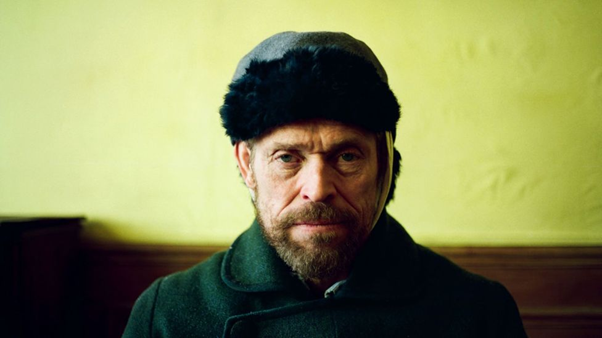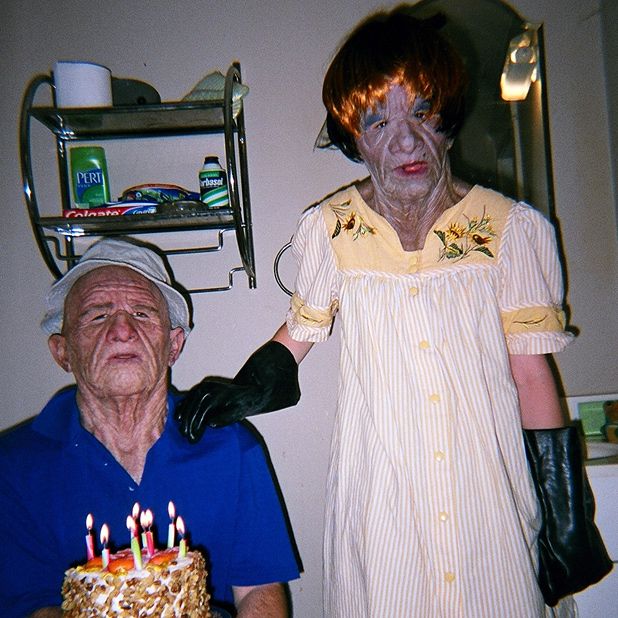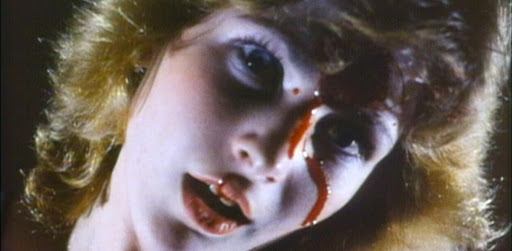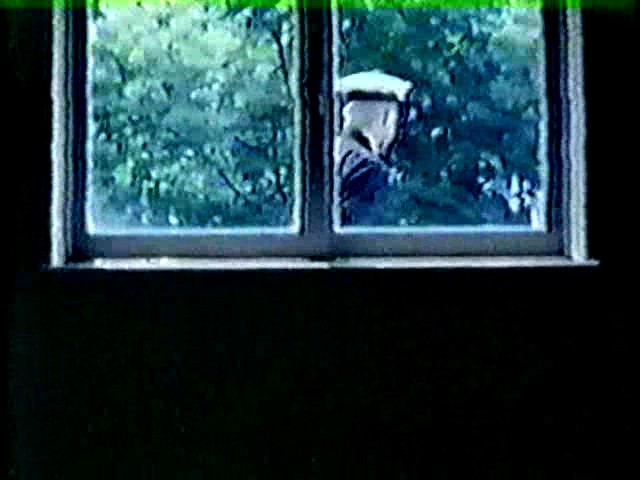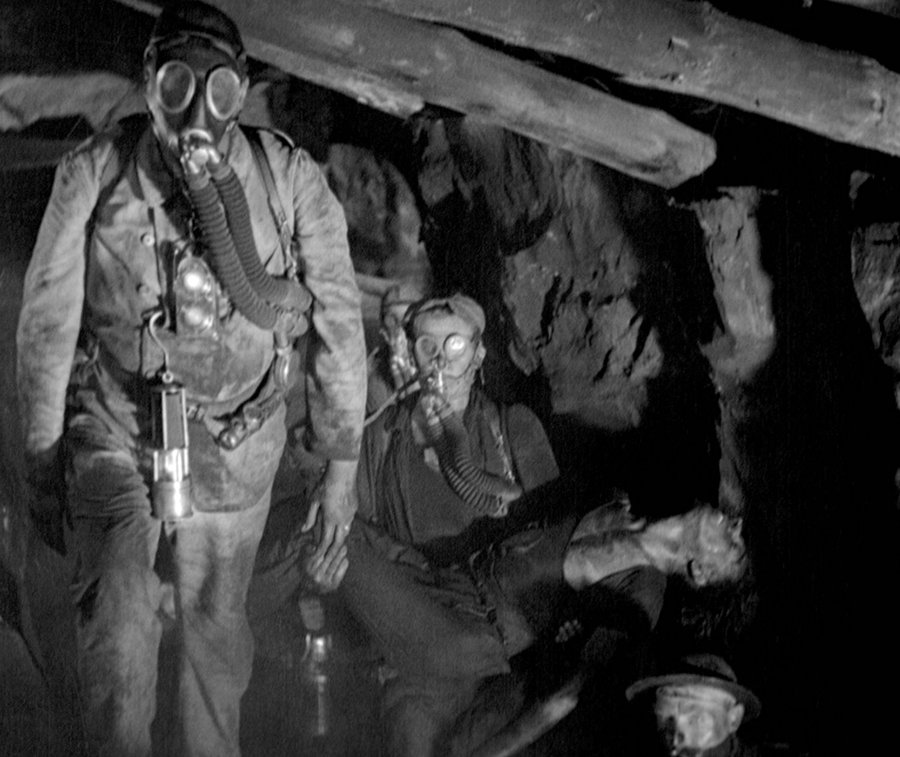To motivate myself into being a better writer, and also to be more well-rounded culturally, I have embarked on a project to watch every video in the Film section of the invaluable online treasure-trove UbuWeb. I will randomly select an artist, and watch every one of the videos pertaining to that artist; once I have done this, I will randomly select another artist and start anew. I will write up my thoughts on the videos pertaining to that artist, however disparate or incoherent, here. I hope that by declaring this so openly, it will create a culture of accountability to myself that will see me through the project. This is the first entry, and the artist is Harrell Fletcher.
Continue reading “The UbuWeb Project #1: Harrell Fletcher”Tag: film
Subjective Gaze in At Eternity’s Gate
“God is nature, and nature is beauty.”
Julian Schnabel’s At Eternity’s Gate, a biopic of Vincent Van Gogh (Willem Defoe), is a lush and pastoral film, imbued with the same depth and tactility that characterised the artist’s paintings. It is full of ruminations on beauty and nature, such as the above quote, but it curiously seems to argue against those things as a salve or saviour; although they made Van Gogh’s life more tolerable, and deeply informed his art, they were ineffective in saving Van Gogh from his inner torpor. Ambiguously, and perhaps wisely, the film doesn’t seek to pathologise or categorise, with a modern lens, whatever it was that afflicted the great artist, and instead simply shows scenes from his life as Van Gogh might himself have experienced them.
Continue reading “Subjective Gaze in At Eternity’s Gate”Inveterate Scumbags: Some Thoughts on Trash Humpers
Harmony Korine’s Trash Humpers oozes with a fetid stink, a grimy and seedy riff on collapsed memory, VHS aesthetics, ‘trailer-trash’ subculture, and the vagaries of Americana. It is a film of situations but with little plot; Korine’s interest in showing the aimlessness of these lives matched only with his disinterest in telling a conventional story.
We follow a gang of four nameless, inveterate scumbags (the ‘Humpers’ of the title), all donned in Freddy Krueger-esque old person masks as they go about causing disturbances on the outskirts of Nashville, Tennessee, and interacting with various locals somehow even more disconnected than they are. It’s a road movie (that great American genre) from the depths of suburban hell and a series of vignettes with no overarching intent other than a feeling of unease, as if Jackass had been made in the 1980s as an SOV experiment by Nick Zedd and shot entirely in a town left behind by society and progress.
Indeed, although it is situated in the backwoods of America, it takes place somewhere closer to the backdoor of the American soul, and reading about the ineffectiveness of polling in the recent American election made it hard not to think about the abandoned ghosts Korine presents us with. They spew racist diatribes, tell circular anecdotes, and menace the meagre whisps of society that have curlicued around them. They are ‘liberated’, but completely isolated, suggesting not so much Walden as Bickle.
The film makes its bona-fides explicit in one of the earliest and most directly unsettling scenes. The Humpers speak with a nameless young child (bunking off school) who, among other things, shows them the best way to suffocate a baby doll with a plastic bag, before beating the doll with a hammer. It’s an obvious and arguably cheap trick to portray a child behaving in such a disturbed manner which is redeemed (if such a word is appropriate) by Korine’s commitment to its effects. Every single aspect of the scene is maximised for audience discomfort (right down to the whip that the child holds while being pulled along by one of the Humpers in a wheelchair), and it is an effective tone-setter.
However, more than being simple ick-gimmickry in search of a reaction, Korine seems to be articulating and critiquing the inbuilt aversions within us that cause negative reactions to certain things that just feel off. Indeed, the whole film is a catalogue of things that are ‘wrong’ made by someone indelibly in love with images. other than the scene described above it’s sometimes hard to pinpoint why. The Humpers often tap-dance after completing an act of vandalism; they’re prone to not reacting, or to staring into space as the camera looks at them; they do, indeed, hump an awful lot of trash, as well as fellate low-hanging branches.
Taken on their own, most of the things that happen in this film skew more towards the mindless and banal as opposed to threatening. Instead, there seems to be a sense of menace around all of the things that the Humpers do, as if the aesthetic mode by which Korine has captured these things imbues them with a feeling that isn’t inherent within the actions themselves. The film is not wholly sinister, however; Korine has also spoken of the beauty of the streetlamp, and there is a perverse beauty in some of the shots of highways and streets that Korine films at night, lit by these lamps.
Within that light, Korine seems to be suggesting, is a world of possibilities, and in that spirit it seems fair to describe Trash Humpers as a free film; free from standards of narrative, cleanliness, audience enjoyment, comfort. The laughs that punctuate the film, coarse and shrill titters that unnerve and unsettle, are so abstract as to cease even being laughter; but they are nothing if not liberated. The only concession to cinematic technique is in the editing; to signal the end of a segment, Korine fills the screen with VHS snow while cutting from one shot to another to the other. It’s easy to miss, and the effect is one of continuity; in its own way, it’s not dissimilar to Hitchcock dollying into a partygoers back in Rope to continue the effect of the ‘unbroken’ shot.
With all this in mind, the key to fully understanding the film is in Korine’s note included in the DVD release, in which he states that Trash Humpers is a sort of tribute to a group of old perverts he used to witness as a child;
‘i remember when i was a child there was a small group of elderly people who would hang out in the back alleys and underbridges by my house. they always seemed to be getting drunk and dancing. one night i looked out my bedroom window and saw a gorup of them humping trash cans and laughing. it sounded like they were speaking a strange invented language.
This is a film about them.’
Taken as a document of, or elegy to, or examination of, a series of images that lodged in Korine’s brain as a child, it takes on a probing hauntological quality.
It almost invites you to locate your own series of formative images, those grimy resonances that you carry with you through to adulthood. I can recall mine, or at least, the impression of mine; illicit looks at hidden VHS tapes of horror films that had been bought by older kids with more lenient parents than my own; a red-brick wall, standing solitary as the other three walls comprising a house that once was lie in rubble around it; the long grey line of the British high-street, flanked on either side with charity shops filled with dead men’s clothing and betting shops filled with dead men; the smell of cigarettes and old ruddy-faced drunkards with sallow eyes talking aimless dribble in pubs with carpets the colour of grey and puce.
It is easy to write Trash Humpers off as a slight and trite piece of provocation. But in mining something that lies so close to his own subconscious, what Korine is really doing is inviting you to bask in the 4am glow of a (sideways and warped) reminisce of a formative moment in his aesthetic development. It is a film about recollection, about finding the beauty in the failure of the American dream, about liberation, about bad taste. Stan Brakhage wrote of the power of film to liberate the adult viewer in the reconstitution of potent childhood visions, and asked the immortal question ‘how many colours are there in a field of grass to the crawling baby unaware of the word green?’
Korine, in his turn, seems to be asking how many lost souls you can capture in the analogue slits of the VHS tape, in the neverending panorama of the yellowing light of a street at night, and yes, in the bottom of a discarded trashcan.
I believe it is no less valid a question.
Staggering About The Ruins of Doris Wishman’s ‘A Night To Dismember’
Nobody has quite done to film what grindhouse culteur Doris Wishman accomplished in 1983’s A Night To Dismember. Caliginous and schizophrenic, it resides inside the fetid corpse of the slasher movie and attempts, with results that oscillate between unsettling and unnerving, to manipulate the cadaver like a puppeteer. It is a special case, however, and not merely the result of ineptness. So the story goes, during editing Wishman had reels of the film stolen, and so the film had to be stitched together out of the remaining footage and papered over with voiceover and repetition.
The disjointed result is a clear instance of the slasher genre, but not an example. The plot is a recognisable riff on the trope of the ‘recently released former child killer’ plot (Blood Rage, Halloween), and it even has a completely un-telegraphed twist (the killings were actually done by the protagonist’s sister!) but it is impossible to be watched as a narrative. Due to the distance between what is on screen and what the voiceover tells us is on screen, it is unable to achieve requisite unity of action that a narrative film requires; its predominant aesthetic mode is a distended series of stylistic looks, hints, and movements. It recalls moments and themes in other films of its type but operates on its own plane of unlogic. It is recognisable, but never lucid; unclear, but always potent.
It is not without its considerable effects; Wishman’s attempts to force the square peg of her footage into the round hole of a coherent narrative results in a ceaseless, singularly queasy tension. This is, by accident or design, a visceral and often upsetting film, markedly more impactful and memorable than any number of the other sleazy ‘boobs-and-beheadings’ slasher films released in that decade. It is too unselfconscious to be avant-garde but too mannered and deliberate to be a pure genre example; it takes place well beyond the usual markers and codes by which we delineate good art and bad art. Taken strictly as a film, it is an unforgivable piece of the most gutter-low trash that surely ranks as one of the worst films ever made. Viewed as a text, however, it becomes something else.
It makes the most sense, and can be redeemed, when viewed as a theme-piece on trauma and grief. Where horror films usually ‘use’ trauma or expressions of shock as a device of acknowledgement to give shape to the diegetic killings (most often in the cut-away to the lone woman screaming), or even in recent years articulate the terror from within the framework of trauma (Rob Zombie’s works being a fine example of this), A Night To Dismember articulates its trauma from within the shape of the film itself. It is a film that portrays no recognisable human emotions, and yet is as upsetting to watch as someone with a broken leg trying to walk a mile.
When viewed as an attempt by an artist to salvage her vision after it was snatched away from her, the film takes on a lingering, haunted, almost poignant quality. Male filmmakers are seemingly incapable of talking about their films without resorting to either a breakup cliché, or a cuckoldry metaphor, and yet Wishman silently, almost stoically, fronts what remains of her work with no guile or pretension. The result is febrile outsider art, as if Stan Brakhage remade the Evil Dead.
Ultimately a distended auteur piece, A Night To Dismember achieves a tricky artistic validity through the sheer force of Wishman’s will. The re-use of the same shots across the same scene feels more like layering than lazy repetition, like a noise artist playing with textures. The already remarkable gore effects grow more unpleasant through their decontextualization; it is one thing to see someone’s fingers be chopped off, but not being able to parse whose fingers, when, where, and why, heightens the impact of the event and strips it of the mitigating factor context. We will see a reaction shot before we even see the moment of impact; then, after the moment of impact, we return to the reaction shot, culminating in a distressing lopsided rhythm. Characters speak, and then the return dialogue will be in voiceover that doesn’t even attempt to match the lip movements. Even the scenes of nudity contain an unpleasant and seedy undertone, which is perhaps the most surprising thing given Samantha Fox’s adult work.
Is there any worth to watching films like this? The concepts of taste and merit have been debated to death, and we seem to have settled on an understanding that a work doesn’t have to be ‘good’, as long as it is meaningful to people. Reception studies, a current strand of film theory, is founded on the predicate that there is value in how people have assimilate art inasmuch as there is value in the art itself. I’m partial to reception studies, because it seems to break out of the idea of ‘good’ film ad ‘bad’ film. This view of cinema is binary, and like all binaries it locks you into a thought pattern that is restrictive, limiting, and unhelpful.
So. In my quietly disturbed way, I found this film to be exceedingly meaningful, more so than a lot of prestige films and even other low-grade films of this type. It is a terrible, rotten, unpleasant work, dripping with abrasive textures, coming apart at the seams so forcefully it’s hard to see where the seams might once have been. There is no beauty in the brutality, but there is something incredibly compelling about looking into the black hole where beauty, and craft, and skill might once have been. It engaged me more thoroughly than most of what I’ve seen this year. All throughout A Night To Dismember, Wishman’s original vision peers out from behind the curtain, but never comes into full view.
Is it not true that all tension arises from what is concealed?
Back And Forth (1969), dir. Michael Snow
Michael Snow’s 1968 film ‘Back and Forth’ makes a chiral out of limitation and potential, proving with deftness and rigour that the two seemingly disparate concepts can work as one and the same when the conditions are right. The form of his film is simple; a camera moves, fixed, back and forth, panning a run-down and dimly-lit classroom. When it hits the edge of what is presumably a block, there is a tap, or knock, and then the camera moves the other way. This is the film, over and over again, in various permutations for 50 minutes.
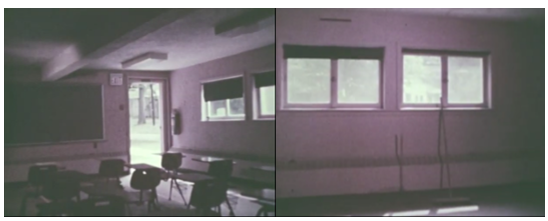
The speed at which the camera moves varies, sometimes moving so fast that it becomes a blur, sometimes so slowly that it is minimal. There are large swathes of the film where nothing is happening, other than this movement (and even when something is happening, it is not in clearly defined narrative terms- more like arrangements within the frame, such as a large gathering of people, or someone in the doorway, or window).
It is a highly conceptual piece, and indeed Snowworks under the umbrella of ‘Structural Cinema’. This was a name coined by P. Adams Sitney, in relation to a loosely connected group of avant-garde film artists who worked within a post-Brechtian reduction of the moving image to its most composite elements, in an attempt to force the viewer to question their most basic notions of cinematic perception.
As Snow sketches his film, it operates like the inverse of Brakhage’s process; if Brakhage (who was not part of Structural Cinema) sought to dismantle the logic of human vision by rendering cinematic images from the outside as disparate, abstract compositions, constantly shifting and evolving, then Snow works within restricted forms of those images to indicate their haptic potential if handled in the correct manner. Snow’s method also resembles a filmic equivalent of Boulez’s ‘Structures’, which used integral serialism to explore possibilities for new sounds distinct from more traditional compositional technique.
(indeed, if Brakhage and Snow are aesthetic opposites, then Snow attempts, roughly, a Brakhagian image in the ‘climax’ of this film, and it’s notable how much remains legible even as the image falls apart in front of us)
As the camera continues to move back and forth, back and forth, the viewer cannot help but be drawn in. My assumption that there were two main fields of vision gave way to the realisation that there are four- the camera view from the left, and the camera view from the right, but then the view from right-to-left, and left-to-right, each having distinct visual perspectives and capturing particular specifities of motion. Indeed, it seems to recall Boulez’s wish to find ‘a perfectly new synthesis’, one ‘not corrupted from the very outset by foreign bodies’.

The way the camera pans (as opposed to tracking, or dollying) indicates a swinging motion not dissimilar to digging, and the repetitious rhythm feels a little bit like something is being carved, a new visual revelation with each movement. One morbid reading could be of the camera and cinematography as a pendulum, swinging closer and closer to a destination that is perhaps out of reach.
Any morbidity could be corroborated by the fact that the film does, in some way, function as a horror film; it certainly articulates in a primitive form a number of techniques which would go on to become horror shorthand in the genre’s 70s heyday. The constantly shifting frame from such a rigid and fixed position ‘traps’ the viewer, as if you can look left and right but not move your head. Whilst this sensation does abate, there are moments when a figure will suddenly appear in the hallway, or window, and disrupt the field of vision in an upsetting way.
Whilst these figures are not in themselves scary (as horror-proper images they would be crude and unsophisticated), the horror comes in the discrepancy between how Snow attunes the viewer so acutely to the frames’ tightly controlled minutiae, and the seemingly random way in which he inserts various elements. This, coupled with the sense of being ‘trapped’ is perhaps a distillation of the horror mechanism to its most basic form.
When it is not scary, it is fascinating. In one spellbinding instance, a woman walks slowly across the room while the camera pans seems to divide the woman into different, liminal, captured spaces; first she is on the right of the room, then the camera moves left, then back to right, and she is gone; the camera moves left again, and she is there; the camera moves right, and then left, and she has left through the door. In its way, this sequence tells you all you could ever wish to know about how the movie camera delineates space through visual editing, assigning value to arbitrary potions contained within its field of view (within an unbroken shot, no less) that are tactile, interactive.
Whilst the work sounds repetitious, as if it has repetition baked into its DNA, Snow seems to undermine the concept of repetition within this work. If repetition, as typically defined, is seeing the same thing over and over again, then Snow does not fit that definition. It initially seems to operate as a cinematic epanalepsis, repeating the ‘clauses’ within Snow’s one cinematic sentence by returning to them with each swing of the pendulum-camera.
Snow injects too much variation, via speed and mis-en-scene for us to consider the image as being truly replicated. As the work continues, Snow’s images and allusions take on the quality of layers of butter pressed between pastry being folded and rolled, one layer becoming two, and then four, and so on.
Erin Manning has written in her work ‘Relationscapes’ that ‘stability is vision’s illusion’. What we take to be stillness is actually ‘an appearance of the composed relation across moments’. There is no such thing as stillness, only an illusion which we take for granted. In this same manner, Snow creates a ‘composed relation’ which, whilst having the form of one thing (a fixed series of shots), slowly reveals itself as multitudinous and aesthetically dense. In probing so deeply into his own, self-composed ‘vision’s illusion’, Snow’s effect calls into question the very nature of cinema, of images, of watching. It is a deeply vital work that anyone even halfway interested in cinema-as-art should immerse themselves in.
To have created so much from so little is a form of wizardry.
5 Thoughts About Training Day
I watched Training Day. Here are 5 thoughts about it.
Exploring The Ineffable Physicality of Jean-Pierre Léaud in Nobuhiro Suwa’s The Lion Sleeps Tonight, and other works
“You have to walk hand in hand with death through life.”
This is the truest line of dialogue spoken in Nobuhiro Suwa’s flawed yet captivating 2017 film The Lion Sleeps Tonight, and it is a barefaced lie. It is spoken by Jean Pierre Léaud, playing a thinly veiled version of himself, called Jean. The words are to his ex-lover, Juliette (Pauline Etienne) who may or may not have committed suicide, but did die mysteriously, at the age of 23. Jean, now 72, has started to see her, her ghost, her essence, as she has been preserved in his memory through Jean’s long years without her.
Skinflicker
A conflict has been percolating for some time, between the responsibility of art in a violent world, and the idea that art has no responsibilities. Slightly different from the idea of censorship, manifestations of this conflict have lead left-wing protestors (typically anti-censorship) to do things like boycott an X-Men film (ostensibly a children’s film) because of a poster showing a woman being choked, and right-wing protestors (usually pro-censorhip) to hide their arguments behind the flimsy muslin gauze of ‘free speech’. A very charitable reading of this debate is that people are demanding higher standards from their art. A less charitable one might be that people, as Jarett Kobek has observed, are so saturated in capitalist media that the very act of seeing a superhero film can be considered ‘activism’, and thus people are requesting that the landscape fit their beliefs.
When A Film Is No Longer A Film: Re-Examining My Relationship with Three Colours Blue.
Three Colours Blue was the film that made me a cinephile. It was among the first films I wrote about, after I first watched it at the age of fifteen. It is the film that both shaped, and thus limited, my view of what cinema was capable of, and that first viewing eight years ago was akin to a religious experience. It tells a simple story, of a widower coping with the loss of her husband and daughter in a car accident, through her attempts to ‘free’ herself from her grief (the film is modelled on the French ideal of liberty), and yet seeing it for the first time I felt my soul being lifted up, to places other films were simply incapable of reaching. It was the first film that felt like it was being born inside my eyes, relentlessly alive and almost conscious.
Finding Hope in G.W Pabst’s Kameradschaft (1931)
I attended this screening at the Friends Meeting House in Brighton last night, as part of a series of screenings hosted by OpenColour. They obviously care deeply about film, and deserve any serious filmgoers support and attention. It was an honour to attend and I feel lucky to have been there. Information can be found here: http://www.opencolour.co.uk.
Continue reading “Finding Hope in G.W Pabst’s Kameradschaft (1931)”
